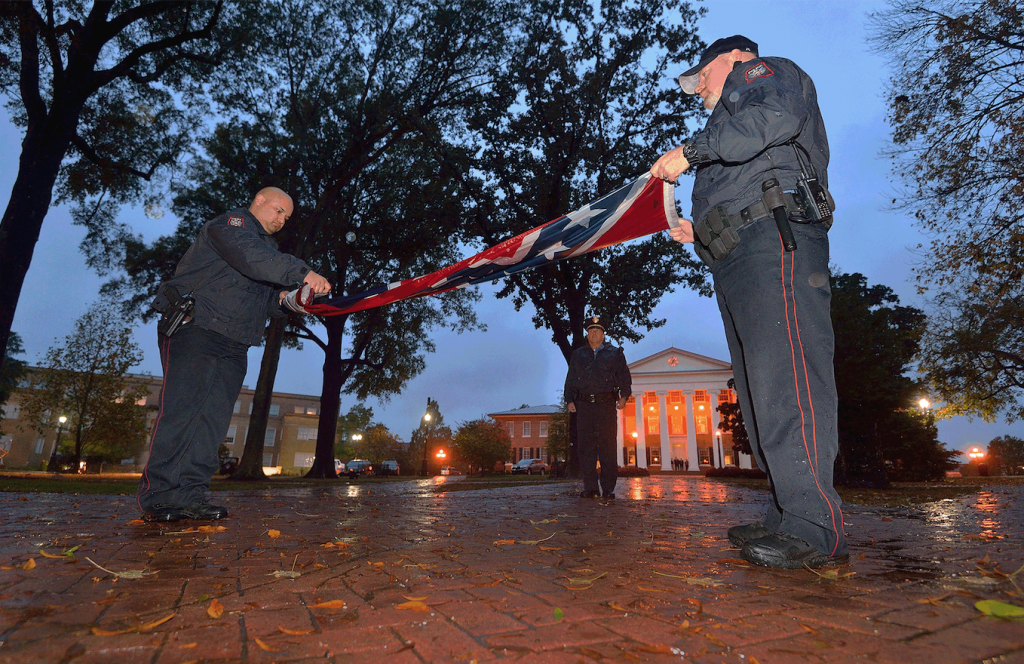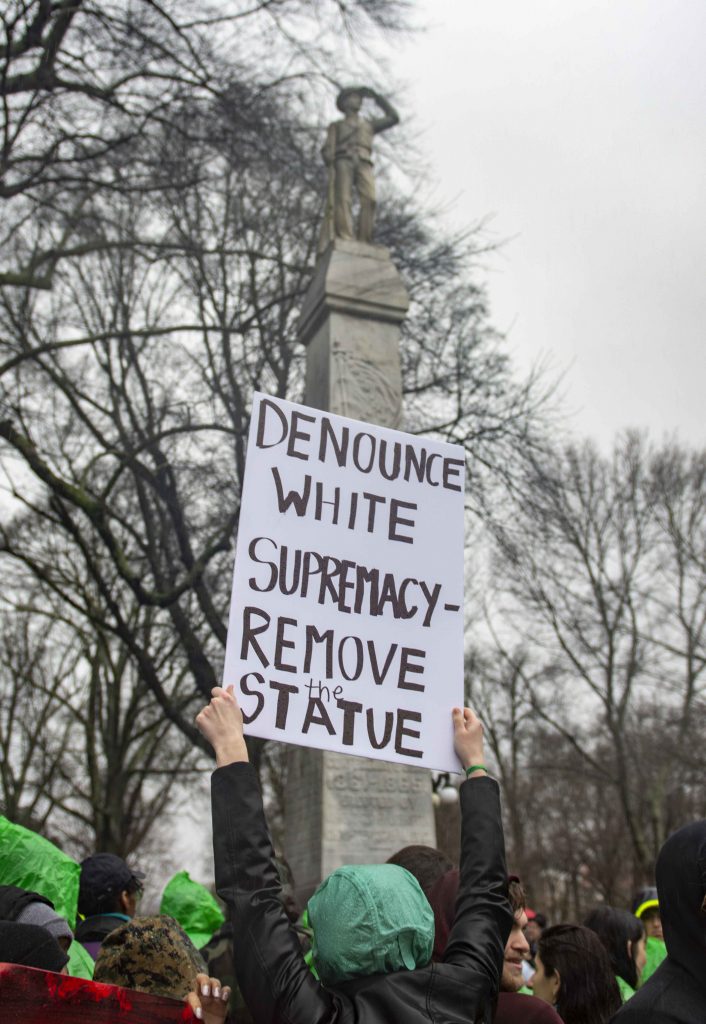It could happen. Student leaders at the University of Mississippi are taking steps toward removing the Confederate monument from the center of campus.
Campus senators met with local historians and administrators this month to discuss options for removing the university’s Confederate monument from the Circle, and on Tuesday night, Associated Student Body senators approved a draft of a resolution in committee which would call on university administration to relocate the monument.
The monument, erected in the Circle 1906 and dedicated by residents of Lafayette County, served as a rallying point for neo-Confederate protesters this past weekend. In 1962, students rioting against James Meredith’s integration of the university gathered at the base of the same monument.

Neo-Confederate protesters leave campus after rallying around the Confederate monument. Photo by Mackenzie Richmond
According to a memo dated Feb. 26 released by the Associated Student Body Senate’s committee on inclusion and cross-cultural engagement, senators plan to seek support from the Faculty Senate, Graduate Student Council, Staff Council and administration in order to relocate the monument to the Confederate cemetery on campus. These groups represent some of the same university bodies that were involved in the school’s decision to remove the state flag from campus in 2015 and to remove Ed Meek’s name from the School of Journalism and New Media in 2018.
An earlier draft of that memo dated Feb. 22 showed Erica McKinley, the university’s general counsel, implying that the university or another “governing body” could make the decision to remove the monument. That memo, which was obtained by The Daily Mississippian, explains that the authority to remove the monument does not lie exclusively with the state government “unless an attorney general deems otherwise.” Authors of the memo said this earlier version unintentionally contained those statements but made no indication of why those opinions were initially included.
In October 2017, Deputy Attorney General Mike Lanford said Confederate monuments can be relocated as long as they remain on similar public property.

University of Mississippi Police Department officers fold the Mississippi flag after removing it from the flagpole in the Circle in 2015. Photo Courtesy Robert Jordan, Ole Miss Communications
Two years earlier, in October 2015, the ASB Senate passed a resolution encouraging the removal of the Mississippi state flag from campus, and within a week, administration made the decision to officially lower the last remaining state flag on the Ole Miss campus.
In a statement released by the university, then Interim Chancellor Morris Stocks said the campus and community discussion inspired the administration to act quickly with the removal.
The ASB rules committee will review a draft of a resolution calling on the university to remove the monument before that legislation potentially comes to the Senate floor next week.
“I don’t think it’s any coincidence that this (resolution) is coming on the heels of last weekend,” ASB Vice President Walker Abel said. “I think it’s a very well-written bill, and at this point, it’s well-researched.”
In addition to meeting with official campus councils, senators met with other student leaders, including College Democrats and student ministries, to bolster support for relocating the monument.
“This is not something that has been rushed in any way,” said John Chappell, president of College Democrats. “A lot of research has gone into it.”
The ASB memo shows that senators met with former members of the Chancellor’s Advisory Committee on History and Context and other experts on campus race relations from the William Winter Institute for Racial Reconciliation and the Center for Inclusion and Cross-Cultural Engagement.
Last night’s proposed resolution comes just hours after the university hosted two forums where students and faculty members asked the university administration to take action and begin the process for relocating the monument.
Junior biology major Jojo Brown attended the students’ forum, hosted by Vice Chancellor for Diversity and Community Engagement Katrina Caldwell, and said she wanted to know how to remove the statue from the center of campus.

SASI demonstrators call for the removal of Confederate symbols such as the monument in the Circle on the Ole Miss campus on Friday. Photo by Christian Johnson
“I will take whoever’s email. I will make however many statements I need to do,” Brown said. “Coming here as an African-American female, everywhere I go, somebody says, ‘Why would you go (to the University of Mississippi)? It’s racist. They don’t want you there.’”
Sophomore political science major Mya King said she was tired of coming to the same meetings and “looking at the same people” she sees at every meeting.
“I’m frustrated because we’re talking about the same thing that we talk about in every other meeting,” King said.
At the faculty forum hosted by Provost Noel Wilkin, history professor and director of African American studies Charles Ross said the forum provided a lot of information to the faculty, but he thinks there the university can do more.
“I think this idea that we don’t know what the policy is in moving the statue — I think we need to get some clarity on that,” he said. “Hopefully, administration can move quickly on that, and I’d like to see the administration unilaterally take some leadership.”
At the separate forums, Wilkin and Caldwell both said senior leadership is currently trying to determine who the “governing body” is that would have the authority to relocate the statue.
McKinley said there is a state law referred to as the “monument statute” that states it is unlawful to take down the statue.
“The second part of that statute explains that the governing body may decide that is more suitable for display somewhere else,” McKinley said. “And, what we grapple with here is that phrase ‘governing body’ is not defined.”






